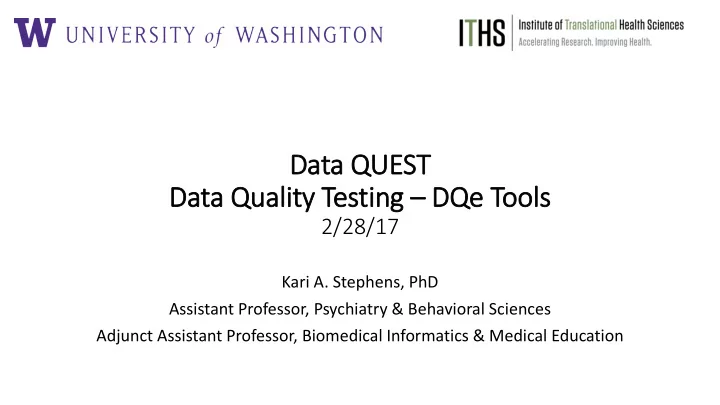

Data Q QUEST Data Q Quality T Testing – DQ DQe Tools ools 2/28/17 Kari A. Stephens, PhD Assistant Professor, Psychiatry & Behavioral Sciences Adjunct Assistant Professor, Biomedical Informatics & Medical Education
WWAMI region Practice & Research Network • ~58 Primary care WWAMI clinics • ~20 data connected clinics CHCs and RHCs • • Underserved populations Many serving rural populations • • Collaboration with national network of practice based research networks • Data QUEST represents over 250,000 patients https://dataquest.iths.org/ https://github.com/WWAMI- DataQuest
Data QUEST • 20 data-connected clinics in the WPRN • Represents over 250,000 patients An electronic health data- sharing architecture across community-based primary care practices in the WPRN
Current Clinical Research Trials Data • Team-based Safe Opioid Prescribing – dissemination trial across 6 regional primary care practices (AHRQ) QUEST: • Integrating Behavioral Health and Primary Care – large national pragmatic trial across 40 national primary care practices Improving (PCORI) Health in Network Participation • PCORNet’s Patient-Centered Scalable National Network for Rural Effectiveness Research (pSCANNER) (PCORI) • Clinical Trials Network: Pacific Northwest Node (NIH/NIDA) Populations • Accelerating Change and Transformation in Organization and Networks III (ACTION III) partnership, The Quality Commons funded by NIH, AHRQ, (AHRQ) CDC, PCORI, AHRQ, • WWAMI Practice Transformation Network (CMS) • Diabetes Prevention Registry (CDC) CMMS, and industry • Northwest Pharmacogenomic Research Network (NIH/NIGMS) • DARTNet Practice Benchmarking Registry (industry) • MOSAIC: Meaningful Outcomes and Science to Advance Innovations Center of Excellence (AHRQ)
Common Tables – OMOP V.4 • Observation • Care Site • Vitals and Labs • Sites at each organization • Past medical history • Condition Occurrence • Family history • Encounter associated diagnoses • Person • Problem list diagnoses • Patient demographics • Drug Exposure • Procedure Occurrence • Medications • Encounter associated procedures • Location • CPT codes • Patient and site addresses • Visit Occurrence • Appointments • Encounters
Current UW-hosted Data QUEST Warehouse Patients Patients 310,604 patients in the person table 350,000 • 102,330 (33%) at Organization B 300,000 • 45,685 (15%) at Organization C 250,000 • 27,577 (9%) at Organization N 200,000 • 36,001 (12%) at Organization P 150,000 • 99,011 (32%) at Organization Y 100,000 50,000 0 10M encounters
Measuring Data Quality A new framework… Operationalizing the framework into: 5 conceptual tests and 17 discrete tests across: Completeness • Are the data present? Conformance • Are the data standardized and formatted? Plausibility • Are the data believable? Kahn et al. (2016). A harmonized data quality assessment terminology and framework for the secondary use of electronic health record data. eGEMS, 4, 1244. https://www.ncbi.nlm.nih.gov/pubmed/27713905
Data Quality Tests TEST ID DOMAIN TEST C1 COMPLETENESS Number of Tables Received, Number of Observations, Flag Indicator for the table having actual data C2 COMPLETENESS GENDER completeness (denominator and proportion with valid data) C3 COMPLETENESS AGE/DOB completeness (denominator and proportion with valid data) C4 COMPLETENESS VITALS completeness (denominator and proportion with valid data): Height, Weight, SBP, DBP C5 COMPLETENESS LABS completeness (denominator and proportion with valid data): A1c, HDL, LDL, Triglycerides, Total cholesterol F1 FIDELITY Check that primary and foreign keys relate properly; High Priority: Person_ID, Visit_Occurrence_ID Duplicate patient check in the patient table (Find the same patient with a different patient ID using full name, F2 FIDELITY dob, and gender) F3 FIDELITY Visualize codes/values entered for DEMOGRAPHICS (Gender, Race, Ethnicity) F4 FIDELITY Visualize YEAR OF BIRTH to help identify errors or missing cohorts Comparison of new load to old load (Number of observations, Number of unique patients, Number of tables P1 PLAUSIBILITY with rows) P2 PLAUSIBILITY Review of minimum and maximum dates for tables with key dates; High Priority: Visit_Occurrence table P3 PLAUSIBILITY How many patients have a year of birth after their visit dates? P4 PLAUSIBILITY Check that certain observation types fall into specific ranges P5 PLAUSIBILITY Visualize number of visits in a year or across years P6 PLAUSIBILITY Visualize type of visit in a year or across years P7 PLAUSIBILITY Volume Check: Proportion of patients with visit data and select observation types P8 PLAUSIBILITY Logical Constraints Check
DQe Tool Architecture DQe-c modular tool developed in R statistical language for assessing completeness in EHR data repositories DQe-v interactive interface powered by the shiny package version 0.13.0 in R
Operationalizing use of DQe tools for data quality testing * Data QUEST * DARTNet Institute
DQe-c and DQe-v Report Flows DQe-v Create a dataset of data Review HTML output for quality related measures data quality issues Read the data and run (for instance, visits per related to plausibility the DQe-v R script year) sorted by measure, across multiple organization, and year organizations DataQuest (OMOP CDM) DQe-c Add-On Main DQe-c Report Run R script for the Review HTML output of Review HTML output of DQe-c Add-On against the DQe-c Add-On Run the DQe-c R script individual DQe-c the individual report for data quality against the CDM for reports for data quality organization report files issues related to each organization issues related to generated during the completeness, fidelity, individually completeness, fidelity, main DQe-c report and plausibility ACROSS DQe-c and plausibility process multiple organizations
The network’s table schemas and key relationships • Color coated to display “missingness”
Completeness example: Number of primary keys for available tables over time
Completeness example: Detailing columns with proportion of missingness (null vs. blank)
Fidelity example: Detailing totals of key overlap across core tables
Completeness/Fidelity example: Percent of patients missing specific key clinical indicators
Completeness/Fidelity example across sites: Percent of patients missing specific key clinical indicators
Completeness example across sites/clinics: Percent of patients missing in columns across sites
Plausability example across sites/clinics: # of Hemoglobin A1c’s per year per diabetes patient with 1+ visit Zoom to 2015-16
Thank you! Next Steps Contact: Kari Stephens • Finalize SOP manual for DQe kstephen@uw.edu • Iterate and refining functionality in DQe-v https://dataquest.iths.org/ • Create standard report of data https://github.com/WWAMI- quality findings DataQuest • Add new tests as needed…
Recommend
More recommend